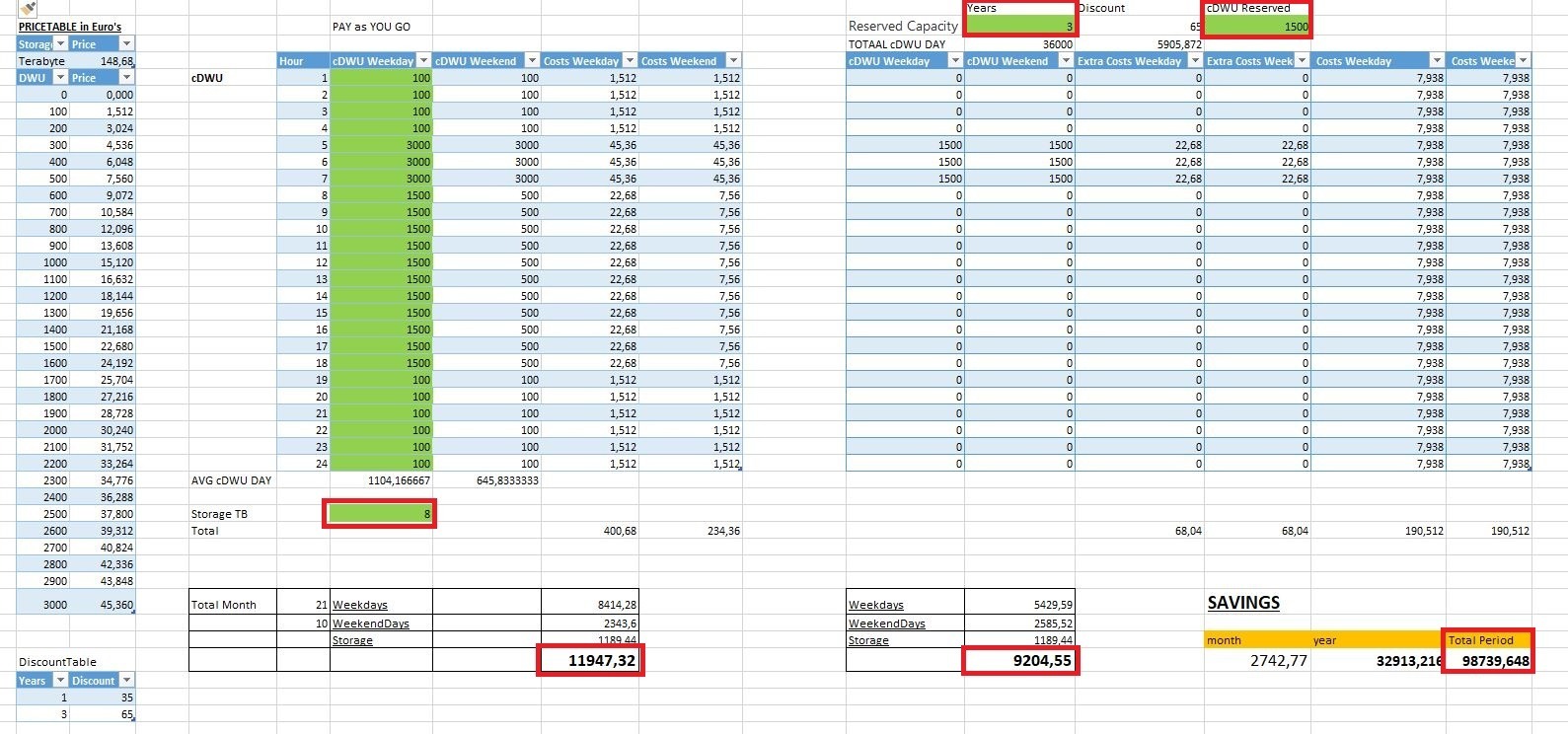Azure SQL Data Warehouse: Reserved Capacity versus Pay as You go
How do I use my Reserved Capacity correctly?
Update 11-11-2020: This also applies to Azure Synapse SQL Pools.
| 12:00 AM | 4:00 AM | 100 cDWU |
| 5:00 AM | 7:00 AM | 3000 cDWU |
| 8:00 AM | 6:00 PM | 1500 cDWU |
| 7:00 PM | 12:00 AM | 100 cDWU |
Weekenddays:
| 12:00 AM | 4:00 AM | 100 cDWU |
| 5:00 AM | 7:00 AM | 3000 cDWU |
| 8:00 AM | 6:00 PM | 500 cDWU |
| 7:00 PM | 12:00 AM | 100 cDWU |
We have separated the weekdays from the weekend days. The SQLDW is used less heavily during the weekend than during the week.
In our calculation we assume that we will purchase a Reserved Capacity of 3 years with 15 units of 100 cDWU. On the left site you will see the Pay as You go model and on the right site the Reserved Capacity.
The amount of Storage will be 8 TB.
As you can see in the example below.

Conclusions:
In the example we see that we have to pay extra if we exceed our Reserved Capacity. These extras are billed with the normal Pay as You go rate.
If we use the Reserved Capacity, we have 1500 cDWU available throughout the day so we don’t longer need to turn it off or scale it down during weekends or outside office hours. Otherwise the Reserved Capacity is wasted for that hour, it doesn’t carry over.
So we actually get more capacity and we pay less for it, sounds great or not! More details can be found here.
In this example, we save nearly 2,750 euros a month, which is almost 33,000 euros a year and 100,000 euros during the 3-year Reserved Capacity period. And that is a considerable amount that you can use to develop new solutions.
| Reserved Capacity | Years | Discount | Month | Year | Total Period | Reserved Capacity | Year | Discount | month | year | Total Period | |
| 1500 cDWU | 3 | 65 | 2742 | 32914 | 98739,648 | 1500 cDWU | 1 | 35 | -2319,41 | -27832,9 | -27832,896 | |
| 1000 cDWU | 3 | 65 | 2261,952 | 27143,42 | 81430,272 | 1000 cDWU | 1 | 35 | -1112,83 | -13354 | -13353,984 |
In this situation we achieve the largest saving with 1500 cDWU with a Reservation of 3 years. When purchasing 10 units of 100 cDWU, we still save but slightly less. When purchasing Reserved Capacity for 1 year, a Pay as You go model will be cheaper.
Calculation Sheet
Since every situation is different, you will have to play with these quantities/units yourself. I have added the Excel form so that you can download it, on which I have based this article. With this form you can fill in your own situation as well as possible. And finally you can take your own conclusions for your customer or environment.
In the sheet only change the Green Marked cells. Prices are in Euro’s.
SQLDWH_-_pay-as-you-go_vs_reservedcapcity
This form has been created together with my colleague Maurice Veltman and we have used it for a solid calculation for 1 of our customers.
If you have any questions or comments about this article or the form, just let me know.





0 Comments